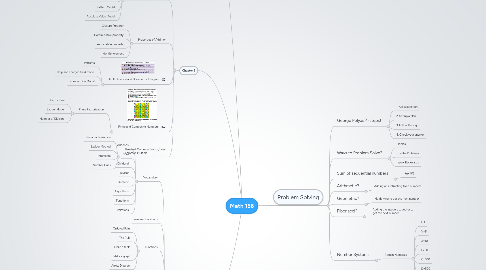
1. Chapters 3 & 4
1.1. Vocabulary
1.1.1. Addends
1.1.2. Sum
1.1.3. Dividend
1.1.4. Divisor
1.1.5. Quotent
1.1.6. Algorithms
1.1.7. Functions
1.1.8. Relations
1.2. Inverse Operations
1.3. Functions
1.3.1. Ordered Pairs
1.3.2. The Rule
1.3.3. Make a table
1.3.4. Make a graph
1.3.5. Arrow Diagram
1.4. Teaching Addition and Subtraction Facts
1.4.1. Counting on
1.4.2. Blocks
1.4.3. Number Lines
1.5. Expression vs. Equation
1.5.1. 10xb
1.5.2. 10x3=30
1.6. Repeated Addition
1.7. Identifying Properties
1.7.1. Communative
1.7.2. Associative
1.7.3. Distributive pro. multiply over addition
1.7.4. Identity prob of one
1.7.5. Identity prob of zero
1.7.6. Closure Property
1.8. Order of Operation
1.8.1. P
1.8.2. E
1.8.3. M
1.8.4. D
1.8.5. A
1.8.6. S
1.9. Describing Long Division
1.9.1. D
1.9.2. M
1.9.3. S
1.9.4. C
1.9.5. B
1.9.6. C
2. Chapter 5
2.1. Integer Addition/Subtraction
2.1.1. Charged Field Model
2.1.2. Chip Model
2.1.2.1. Using Red and Black chips to represent Positive and Negative!
2.1.3. Number Line Model
2.1.4. Pattern Model
2.1.5. Absolute Value Model
2.2. Properties of Addition
2.2.1. Closure Property
2.2.2. Commutative property
2.2.3. Associative property
2.2.4. Identity element
2.3. Multiplication and Division for Integers
2.3.1. Patterns
2.3.2. Chip and charged field model
2.3.3. Number Line Model
2.4. Prime and Composite Numbers
2.4.1. Prime Factorization
2.4.1.1. Factor Tree
2.4.1.2. Ladder Model
2.4.1.3. Number of Divisors
2.5. Greatest Common Divisor/Least common Multiple
2.5.1. Prime Factorization
2.5.2. Ladder Method
2.5.3. Intersects
2.5.4. Number Lines
3. Chapter 6 & 7
3.1. Decimals
3.1.1. Adding Decimals
3.1.2. Subtracting Decimals
3.1.3. Multiplying Decimals
3.1.4. Dividing Decimals
3.2. Fractions
3.2.1. Adding Fractions
3.2.2. Subtracting Fractions
3.2.3. Multiplying Fractions
3.2.4. Dividing Fractions
4. Problem Solving
4.1. George Polyas 4-steps!
4.1.1. 1. Ask a question
4.1.2. 2. Set up a plan
4.1.3. 3. Follow through
4.1.4. 4. Check your answer
4.2. Ways to Problem Solve?
4.2.1. Tables
4.2.2. Similar Problems
4.2.3. Work Backwards
4.3. Sum of sequential numbers
4.3.1. n(n+1)/2
4.4. Arithmetic?
4.4.1. Adding or subtracting fixed numbers
4.5. Geometric?
4.5.1. Multiplying to get the next number
4.6. Fibonacci?
4.6.1. Adding the integers together to get the next number
4.7. Number Systems
4.7.1. Roman Numerals
4.7.1.1. I=1
4.7.1.2. V=5
4.7.1.3. X=10
4.7.1.4. L=50
4.7.1.5. C=100
4.7.1.6. D=500
4.7.1.7. M=1000
4.7.1.8. EX: MDCCCL= 1850
